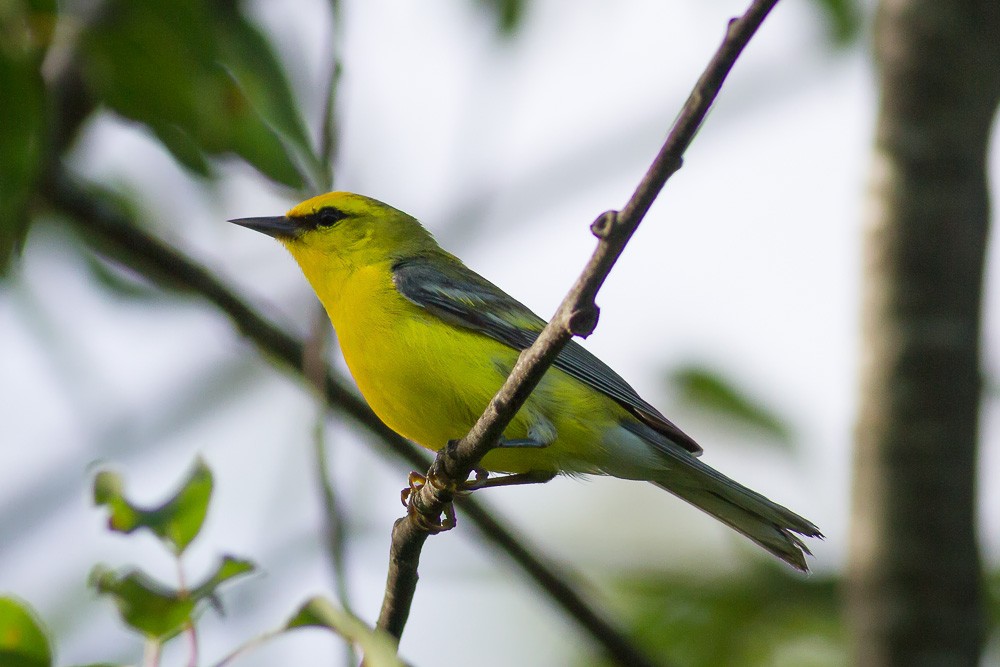Blue-winged Warbler
A species of Vermivora, Also known as Blue-winged Golden Tit Scientific name : Vermivora cyanoptera Genus : Vermivora
Blue-winged Warbler, A species of Vermivora
Also known as:
Blue-winged Golden Tit
Botanical name: Vermivora cyanoptera
Genus: Vermivora
Content
Description People often ask General Info
 Photo By Ken Janes , used under CC-BY-SA-2.0 /Cropped and compressed from original
Photo By Ken Janes , used under CC-BY-SA-2.0 /Cropped and compressed from original Description
The blue-winged warbler is a small warbler at 11.4–12.7 cm (4.5–5.0 in) long, with a wingspan of 17–19.5 cm (6.7–7.7 in). The breeding plumage of the male consists of a bright yellow head, breast and underparts. There is no streaking of the underparts of the bird. It has a narrow black line though the eyes and light blueish gray with two white wing-bars, which are diagnostic field marks. The blue winged warblers are generally small in size with a well-proportioned body, and heavy pointed bill. They roughly measure 4.3 to 4.7 inches long with a wingspan of around 5.9 inches. An average Blue-Winged Warbler weighs around 0.3 oz. The female is duller overall with less yellow on the crown. Immatures are olive green with wings similar to the adults. The color of their plumage tends to vary depending on the sex of the species. For males, the feathers are of bright yellow and olive green. The males often have bluish-gray wings that come with white wing bars and a distinctive black eye lining, making their heads look pointier compared to other male warbler species. Blue-Winged Warbler females exhibit a yellow plumage that looks a bit lighter in color. The females also have a much less prominent eye lining which mostly looks grey and light, rather than black as seen in the males. Immature or juvenile Blue-Winged Warblers are smaller compared to adults and will show a pinkish bill and almost invisible wing bars. The song is a series of buzzing notes. The call is a sharp chip. 
Size
12 cm (4.75 in)
Life Expectancy
7 years
Nest Placement
Ground
Clutch Size
2 - 7 eggs
Incubation Period
1 brood
Number of Broods
10 - 11 days
Nestling Period
8 - 10 days
Feeding Habits
Blue-winged Warbler's diet primarily consists of insects and spiders. These birds forage in various trees like apple and walnut, sometimes hanging upside down to glean insects from leaves, catering to their chicks with larval food such as Aphis and Corythucha sp. They adjust their diet seasonally and by habitat availability.
Habitat
Blue-winged Warbler flourish in shrublands and scrubby areas, often inhabiting forest edges and thickets in their breeding range. These birds prefer open woodlands, gardens, parks, and thorn forests as stopovers during migration. At lower altitudes, the ideal climate includes both evergreen and tropical deciduous forests, with a penchant for forest edges, scrub, and hedgerows. Blue-winged Warbler are typically found in areas rich in undergrowth vegetation, which provides ample opportunities for foraging. They are seasonal residents across eastern North America, extending to Central America in the winter.
Nest Behavior
Female blue-winged Warbler select nesting sites and complete nest construction within 2–4 days.
Nest Characteristics
Blue-winged Warbler typically construct their nests on or near the ground at the edge of forests and scrubs, often at the bases of goldenrods, berry shrubs, or grass/sedge clumps. Their open cup nests are made of grasses, bark shreds, and dead leaves, lined with finer plant materials.
Dite type
Insectivorous
People often ask
General Info
Feeding Habits
Bird food type
Bird Feeder Type

Small Tube Feeder

Platform
Behavior
Blue-winged Warblers exhibit agility as they navigate through dense undergrowth, darting quickly between flights and engaging in brisk hopping. Their foraging is meticulous, with a preference for the outer branches where they acrobatically glean insects, sometimes upending themselves to reach underside foliage. During breeding, males dynamically establish and defend territories, showcasing less site fidelity year over year. Encountering rivals triggers a display of fervent chipping and animated chasing. Courtship is an energetic dance involving crown-raising, tail-flicking, and bill-locking with potential mates. Though pair bonds suggest monogamy, blue-winged Warblers might pursue mate opportunities outside the pair. A notable behavior is their unintentional nurturing of Brown-headed Cowbird chicks due to nest parasitism, often to the detriment of their offspring.
Distribution Area
Blue-winged warblers are migratory New World warblers. They winter in southern Central America and breed from east-central Nebraska in the west to southern Minnesota, Wisconsin, Michigan and southern Ontario in the north to central New York, southern Vermont, southern New Hampshire and New England to the east, south to western South Carolina, northern Georgia, northern Alabama, eastern Tennessee and southern Missouri. It is a very rare vagrant to western Europe, with one bird wandering to Ireland. The breeding habitat is open scrubby areas. The species is widely distributed in North America, with populations found in states such as North Carolina, South Carolina, Connecticut, Florida, Kentucky, Massachusetts, Michigan, New York, and Ohio. They’re mostly found in abandoned fields with shrubs and trees and bordered by tall deciduous trees. The Blue-Winged Warblers are generally found in areas located in higher elevation and high percentage of grass and canopy cover. 
Species Status
Not globally threatened.
Scientific Classification
Phylum
Chordates Class
Birds Order
Perching birds Family
New world warblers Genus
Vermivora Species
Blue-winged Warbler